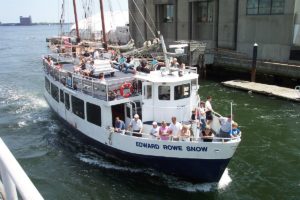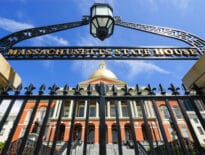
One of the MBTA's Charlestown ferries pulls into Long Wharf in 2006. Photo by Chris Wood | CC BY 4.0
Developers operating in East Boston will have yet another neighborhood feature to point out for potential tenants and buyers: ferry service to downtown.
The MBTA announced Thursday that it was launching a pilot cross-harbor service between East Boston’s Lewis Mall and downtown Boston’s Long Wharf starting Monday after state legislators included funding for the service in a spending bill earlier in the summer.
The move comes after neighborhood residents lauded the temporary ferry service the T ran on the same route during the spring’s maintenance shutdown of the Blue Line’s cross-harbor tunnel. According to the MBTA’s announcement, around 1,750 people took that ferry service, a far cry from the 41,000 people who take the Blue Line every day but a boon for the neighborhood. As the last stop before downtown Boston and the terminus of several important bus lines, inbound trains are sometimes at capacity by the time they reach the Maverick Square station during the busiest times of day.
“We’re pleased to be able to demonstrate this ferry service between East Boston and downtown Boston this fall and next spring,” MBTA General Manager Steve Poftak said in a statement. “We know riders valued the ferry service last spring when Blue Line service was suspended for maintenance. Demonstration projects such as these take coordination and funding, and I’d like to thank our local elected leaders for pursuing and securing the funds necessary to allow the T to operate this seasonal service.”
With its strong transit connections, plentiful ex-industrial land, low home prices relative to the North End and South Boston and proximity to the Seaport District and the Financial District, East Boston has become a destination for investors seeking rental properties, condominium conversions of small apartment buildings and luxury waterfront developments. The neighborhood has also attracted developers pushed out of other hot areas by the blossoming life sciences sector. The intense development attention has prompted Boston Mayor Michelle Wu to push planning resources into the neighborhood to help moderate displacement and gentrification.
The East Boston ferry will run seven days a week during fall 2022 and spring 2023, pausing between Nov. 30 and March 1 to account for the rough and sometimes frozen winter conditions in Boston Harbor. Each trip across the harbor is expected to take 10 minutes. The ferry will run every 30 minutes in the morning and evening, starting from East Boston at 7 a.m. during the week and at 9 a.m. on weekends. The last ferries of the evening will leave Long Wharf at 7:45 p.m. on weekdays and 8:45 p.m. on weekends.
A ferry trip will cost the same as a ride on the subway: $2.40, or $1.10 for seniors and others eligible for reduced fares. Fares can be purchased at the Long Wharf ticket booth and on the mTicket app normally used for commuter rail tickets. Monthly MBTA LinkPasses will also be accepted, the T said.
“This ferry service will be a critical link in further activating the inner harbor and connecting the North End and East Boston. I am proud that we were able to receive state funding to make this investment possible and I look forward to building off its success in the near future,” House Ways and Means Chair Aaron Michlewitz said in a statement. “I want to thank my colleagues in the Legislature, Representative Madaro, and Senator Edwards, for the work they did to help secure these critical funds.”
Michelwitz, Madaro and Edwards represent communities on either end of the ferry’s route.
“The return of the East Boston ferry through the fall season and next spring is a win for residents across our community,” Rep. Adrian Madaro said in a statement. “At a time when increased congestion and transportation challenges have meant more difficult commutes, the ferry will offer people an additional transit option with frequent service at peak hours and at a cost on par with the subway. I was proud to partner with Rep. Michlewitz and Sen. Edwards to secure funding to bring back the ferry, and I’m excited for residents to be able to use this enjoyable, accessible mode of public transit to cross the harbor.”
The ferry service marks the firs time regular passenger service will be crossing the harbor since 1952. Before the Sumner Tunnel opened in 1934, the Tobin Bridge in 1957 and the Callahan Tunnel in 1961, the ferries and the Blue Line tunnel under the harbor were the primary means of getting back and forth between downtown and East Boston and Chelsea, along with an often-congested drawbridge across the Mystic between Chelsea and Charlestown.
This history has prompted some calls in recent years to expand the MBTA’s existing cross-harbor ferry services linking Charlestown, downtown and Logan Airport to include East Boston and Chelsea.
“Finally! It makes so much sense to use our coastline to our advantage,” Sen. Lydia Edwards said in a statement. “We need to build and invest as much as possible in affordable waterfront transportation. This is just the beginning!”






